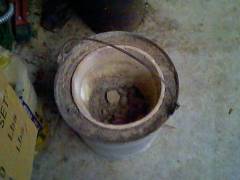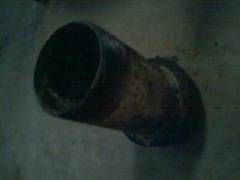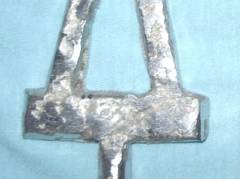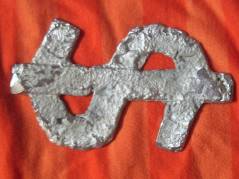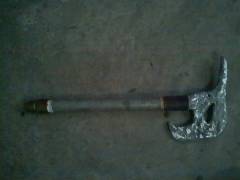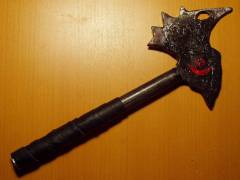I started doing metal casting about a month and a half ago after reading about it on the internet on and off for over a year. The premise is simple: melt zinc (~787F) or aluminum (~1221F) in a charcoal fed blast furnace and then pour into a mold made from a mixture of sand, bentonite clay (kitty litter!), and water.
My furnace consists of a normal clay pot inside a metal bucket with some basic concrete poured between the two. A hole is drilled through the side a little above the base; a 2’x1/2” steel pipe (not shown) feeds air from a hairdryer through this hole and to the charcoal, where it SUPERCOMBUSTS to a temperature hot enough to melt anything I’d care to melt.
I burnt an old broken laptop with it at a LAN party. It was pretty significant.
My crucible consists of a 4” long, 2” diameter steel pipe nipple (teehee) with a hardy steel end cap. I do all handling of it with a set of long, 90 degree pliers and a pair of welding gloves. Although somewhat dangerous, it’s surprisingly not that intimidating.
While I wish I could say that I’m exorbitantly talented with my ability to cast metal, it wouldn’t be close to true – most of my pieces require significant grinding to clean them up after they come out of the sand. I’ve still been able to make some neat things, so far.
The first piece I made – a copy of Hillary’s “bent” from her engineering honor society thingy. We made this during our second time firing up, melting down scrap zinc that I procured while in Albany. For simply pushing the original in our kitty-litter-mix and then pouring molten metal in its place, it turned out surprisingly well.
After a lot of things that didn’t turn out at all (mostly poor attempts at the lost foam method) I was able to make a really scrappy looking piece of bling. While the bent was a copy of an object, this was a more custom design, made by pressing a small wooden block into the sand to create the shape of a dollar sign. Turned out sort of ugly, but at least the shape was recognizable.
The first real thing that was remotely proud of is my hawk axe. The head was an abstract design that I came up with on the spot (sort of based off a sketch I had drawn in a meeting) and was shaped by the same wooden block technique I used to make the dollar sign. I then pressed the top pipe fitting, half filled with sand to preserve the lower threads, into the sand and cast the axe head directly into it. After letting it cool and removing it from the sand I was able to clean it up, polish it off, and screw it onto the handle.
The second axe below was cast in a similar method to the hawk axe, although didn’t firmly cast into the pipe union. I ended up grinding down the base of the head and hammering it firmly into the pipe, allowing for a more seamless junction. I then painted it with acrylic paints (silver zinc looks weird with black steel), covered it with a coating of polyurethane, and then wrapped a strip of black leather around the handle.

